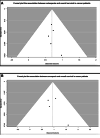Osteosarcopenia in patients with cancer: A systematic review and meta-analysis
- PMID: 39533564
- PMCID: PMC11557054
- DOI: 10.1097/MD.0000000000040476
Osteosarcopenia in patients with cancer: A systematic review and meta-analysis
Abstract
Background: Osteosarcopenia is frequent, and the relative risk of fracture is higher among patients with sarcopenia. It is a strong predictor of poor outcomes in older adults undergoing cancer treatment, suggesting that osteosarcopenia is important in an aging society. This study aimed to evaluate the overall survival (OS) and disease-free survival (DFS) of patients with cancer with and without osteosarcopenia.
Methods: Five electronic databases-Embase, PubMed, Web of Science, Scopus, and CINAHL-were searched for relevant articles published before February 2024. Studies that met the criteria were used to evaluate the OS and DFS of patients with cancer with and without osteosarcopenia. From the 603 initially identified articles, 8 involving 1608 participants were included in the meta-analysis.
Results: We observed that patients with cancer diagnosed with osteopenia, sarcopenia, or osteosarcopenia had worse DFS than those without these conditions. Specifically, osteopenia (pooled hazard ratio [HR] = 1.70, P = .01) and osteosarcopenia (pooled HR = 2.17, P = .0001) emerged as independent predictors of DFS. However, sarcopenia was significantly associated with DFS. The quality of the included studies was generally good, and no publication bias was detected among them for either OS or DFS.
Conclusion: These meta-analysis results suggest that osteopenia and osteosarcopenia are associated with worse DFS among patients with cancer. The use of different case definitions appeared to be a major source of heterogeneity among studies. Further studies are warranted to confirm our findings, especially those regarding OS and DFS.
Copyright © 2024 the Author(s). Published by Wolters Kluwer Health, Inc.
Conflict of interest statement
The authors have no conflicts of interest to disclose.
Figures








References
-
- Binkley N, Buehring B. Beyond FRAX: it’s time to consider “sarco-osteopenia”. J Clin Densitom. 2009;12:413–6. - PubMed
Publication types
MeSH terms
LinkOut - more resources
Full Text Sources
Medical
Miscellaneous

